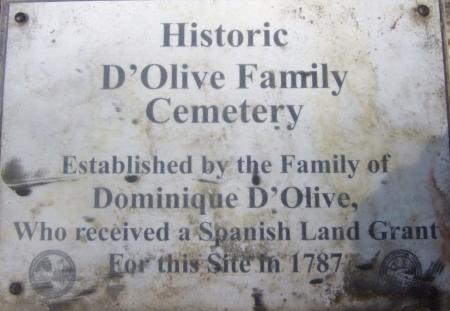D'Olive Cemetery
This burial site dates back to the early 1800s, making the D’Olives the oldest family in Daphne and one of the oldest in Baldwin County. There are several graves remaining in the cemetery dating back to the 1800s with headstone inscriptions in French. It was customary to bury on one’s own plantation, often these silent reminders are all that is left to tell the story of the early pioneers.
The entirety of the O'Olive Cemetery is an acre, The family section was originally surrounded by a wrought iron fence with a gate bearing the family name. It is unknown how many people were buried in this cemetery as many are unmarked. The fence and gate were stolen years ago. (Birth records of the Catholic church show Louis' birth as February 15, 1773, and not 1769 as on the marker.)
An inscription reads “IN MEMOIiY OF LOUIS D'OLIVE, Born 1769 Died 1841 and his wife LOUISA LE FLEAU, Born 1782 Died 1841. Both natives of Alabama this stone is erected as a token of filial Love”.
The oldest marked grave is Mary Blue, a neighbor who died in 1826. She was married to Major Uriah Blue, an officer who served with General Andrew Jackson. Uriah was born in Kentucky about 1776 and married Mary about 1818. When they married, he was 42 and she was 28, In 1820 he resigned his commission and relocated to Baldwin County where his campaign had brought him during the Creek Indian War. Their home was built along the bluff just south of the O'Olive plantation.
The D'Olive Family
Dominique D'Olive came from Toulouse, France, to Mobile during British rule, around 1770 to 1771. He was around the age of 31 and lived on Mon Louis Island south of Mobile at the home of his future father-in-law, whose oldest daughter, Dominique married. He farmed and raised cattle with his father-in-law and invested in land of his own. D'Olive received a Spanish Land grant for the Eastern Shore property in 1787. He never lived on the property which was most likely run by an overseer. His family spent some summer months at the plantation and Dominique acquired adjoining land as it became available. Upon his death, his oldest son Louis took over managing' the family plantation. Louis built a hotel there, La Belle Rose. There were about 1200 acres accumulated by this time.
The French and English were at war, and the War of 1812 between America and the British was raging. Then there was the 1813 massacre at Fort Mims during the 1813-1814 Creek War. Sometime between 1813 and 1814, the family history claims Louis moved his family to the D'Olive plantation. During this period, Indians plundered several plantations includlnq the D'Olive’s. The overseer and three slaves were forcibly taken to Pensacola. All the D'Olive hands were released by the Spanish there and returned to the D'Olives. On another occasion, Louis himself was taken along with a slave "and carried across the county" but Louis and his slave escaped. It was after this time that Andrew Jackson and his forces marched to Pensacola to expel the British and the Red Sticks. Besides raising crops and cattle, Louis operated a sawmill and a brickyard. In 1830, the census shows Louis D'Olive's family living there with eighteen slaves and one free servant making twenty-five total residents. Louis died in 1841 and is buried in the plantation cemetery.
Contact Us
PO Box 1374 Daphne, AL 36526
contact@VillagePoint.info
Copyright 2019 Village Point Foundation
Website by PC
Professionals
Statistics

